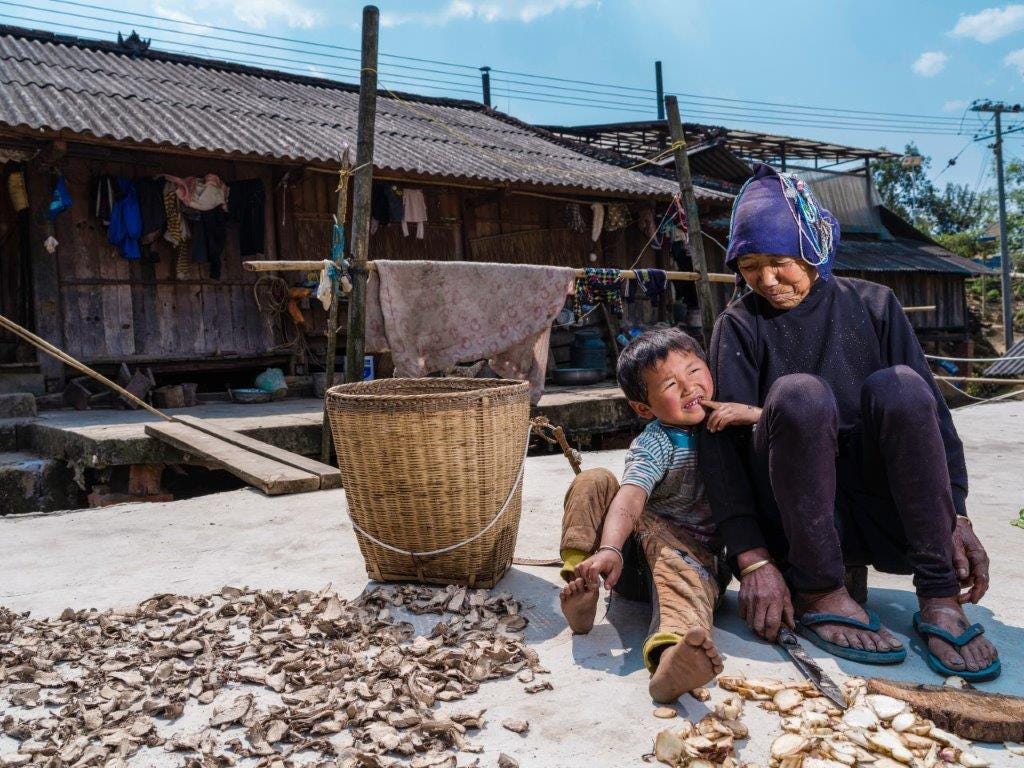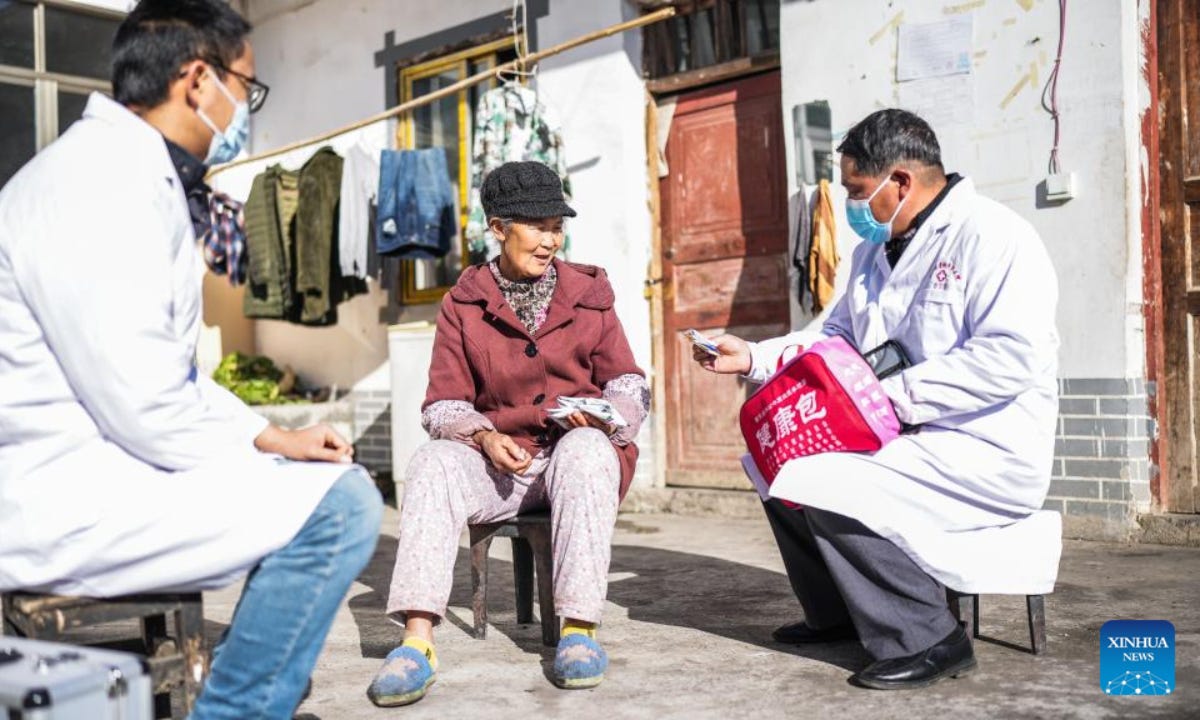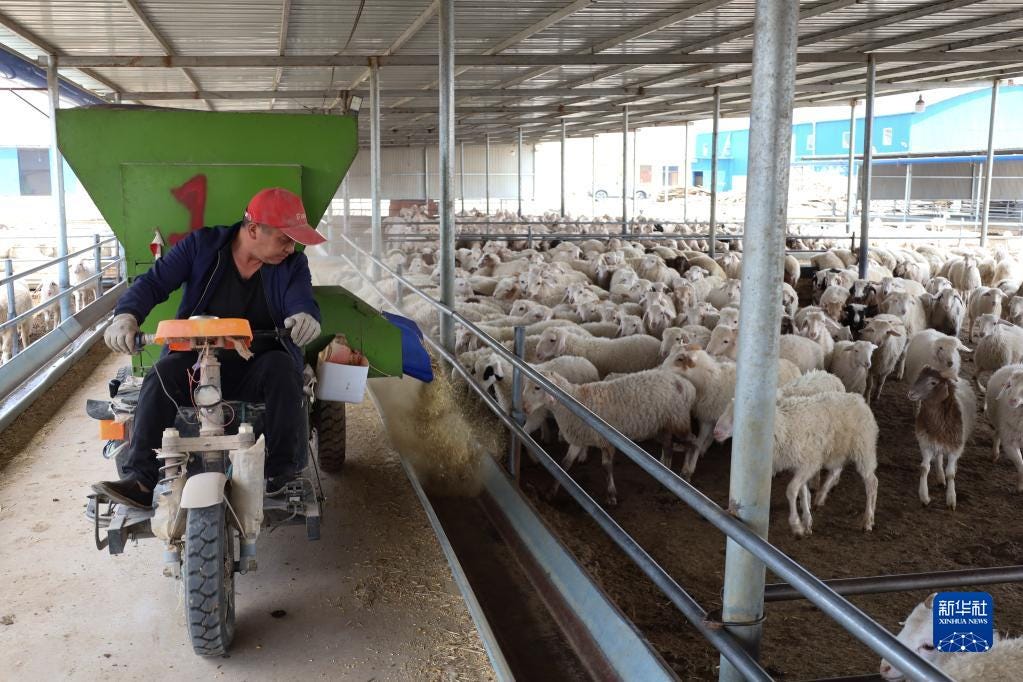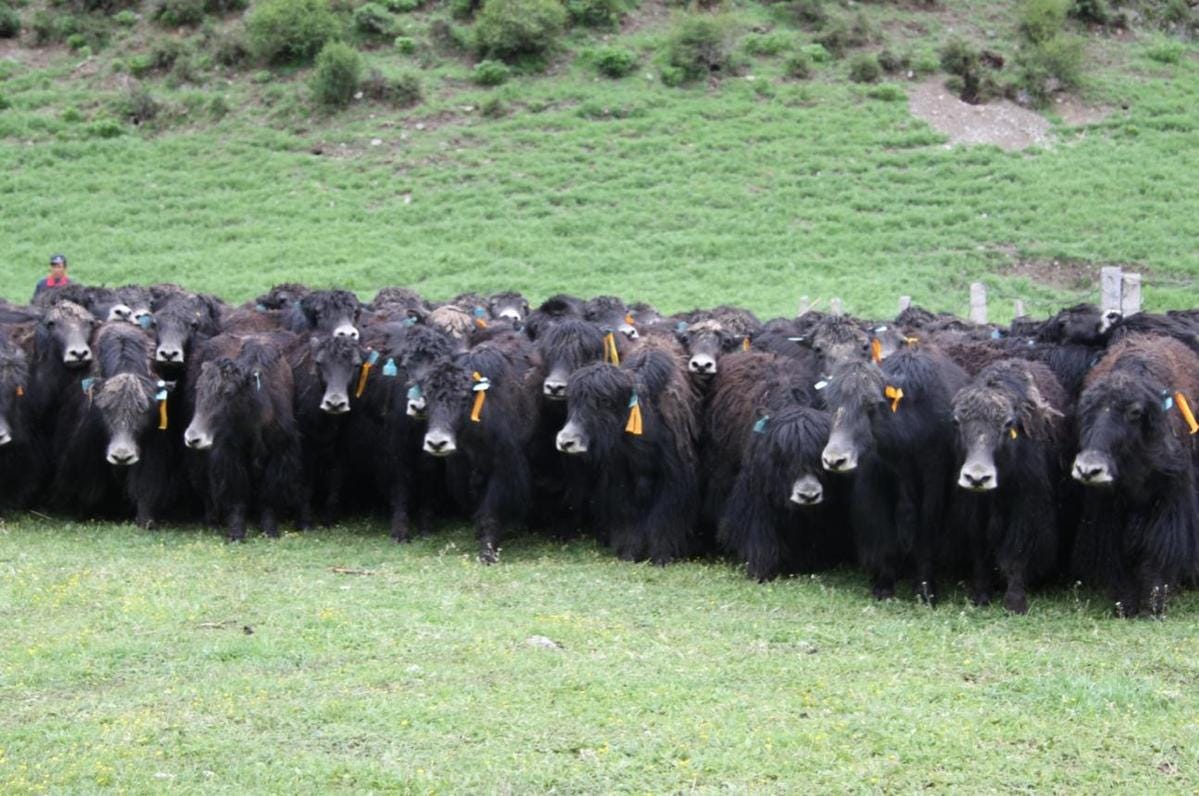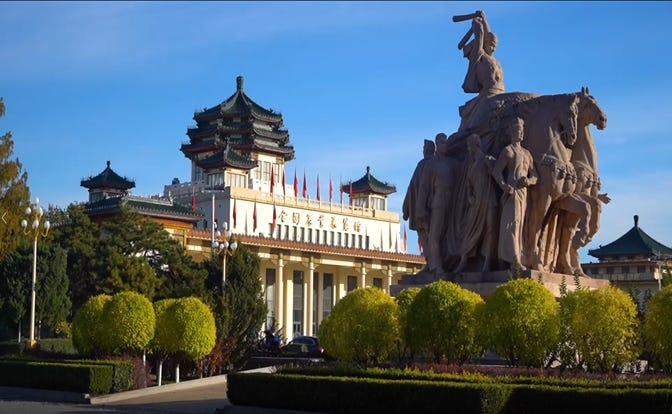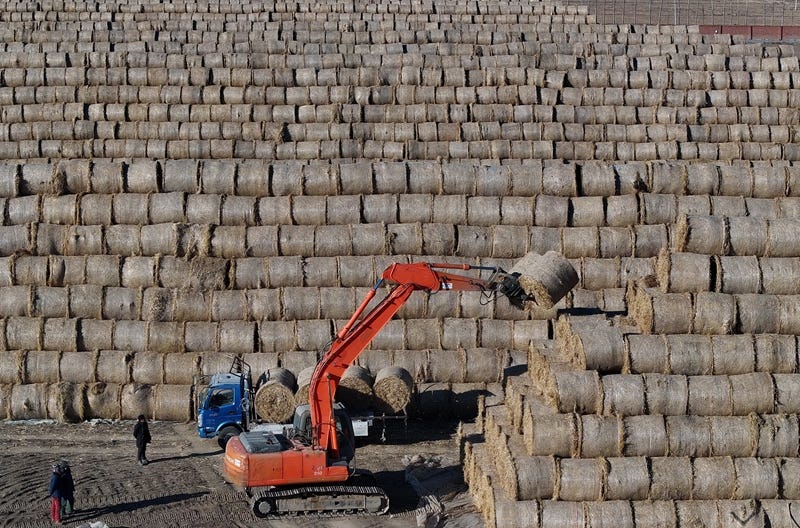The Harvest: This Week in Rural China – Dispatch No. 5 (9 January 2025)
Insights into Rural China: elderly care reforms, Tibet earthquake challenges, Gulang's lamb industry growth, and Qinghai's livestock housing debate.
Welcome to this week’s edition of The Harvest, the weekly dispatch from This Week in Rural China. Across China’s rural landscape, policy shifts, infrastructure developments, and industrial innovations continue to reshape communities, bringing both opportunities and challenges.
One of this week’s major stories is China’s ambitious push to modernise infrastructure in its western provinces—a key initiative announced on 5 January. The full analysis appears in a feature article published on Tuesday, which can be found here. The story highlights the country’s efforts to bridge the developmental gap between urban coastal hubs and western China through improved connectivity, logistics, and trade integration.
In this dispatch, we explore the other key issues shaping rural China this week: new reforms in elderly care, the aftermath of the Dingri earthquake and its impact on infrastructure resilience, the rise of Gulang County’s lamb industry and its sustainability challenges, and a critical analysis of Qinghai’s prefabricated livestock housing subsidies
As always, we welcome your thoughts and reflections. Please feel free to comment below or email nathan@thisweekinruralchina.com.
We hope this week’s dispatch offers valuable insights into the rapid changes and challenges shaping rural China today.
A New Era for Elderly Care in Rural China: Key Reforms Unveiled in Government’s Latest Policy Directive
On 7 January 2025, the Central Committee of the Communist Party of China and the State Council unveiled a landmark set of directives to reshape the elderly care system, focusing mainly on rural areas. The Opinions on Deepening the Reform and Development of Elderly Care Services (关于深化养老服务改革发展的意见) outlines an ambitious approach to modernising elderly care, addressing China’s ageing population and aiming to provide a more equitable system.
With over 60% of China’s elderly living in rural areas, the reforms aim to bridge the gap between urban and rural elderly care. Rural regions have struggled with inadequate infrastructure, qualified personnel, and services for the elderly. The reforms propose integrating home, community, and institutional care with medical services, creating a “three-tiered elderly care network” (三级养老服务网络) to improve access and support.
A central goal of the reforms is to support elderly populations in rural China, particularly those in “empty nest” households (空巢家庭), where many elderly live without close family support. By 2030, nearly 300 million Chinese will be 60 or older, with a significant proportion in rural areas. The new policy will expand elderly care services to address these growing needs.
Key initiatives include:
County-level Elderly Care Management Platforms: Integrating local medical and social services to improve accessibility.
Expansion of Regional Care Centres: Providing localised care in rural areas.
Community-based Care: Offering home visits, meal assistance, and basic healthcare to reduce reliance on institutional care.
These initiatives aim to alleviate the strain on elderly individuals in rural regions, where limited resources and poor infrastructure complicate care provision. Additionally, integrating medical and elderly care will provide better services for elderly individuals, especially those with chronic conditions.
The reforms specifically target “empty nest” families, addressing isolation and lack of support through:
Home Care Services: Healthcare professionals visiting elderly individuals in their homes.
Community-Based Support: Meal delivery, companionship, and mental health services.
Regional Care Centres: Offering more intensive care when necessary.
Financial Assistance: Reducing the cost burden of care services.
These measures aim to ensure elderly individuals can age within their communities with greater access to healthcare and social support. Ultimately, the policy seeks to create a more inclusive, sustainable elderly care system that supports rural families and addresses the nation’s ageing population.
Ancient Wisdom and Modern Strategies: The Rise of the Lamb Industry in Gulang County
Gulang County, located in the eastern Hexi Corridor of Gansu Province, is fast becoming an exemplary model for sheep farming. With a sheep stock of 3.6 million, Gulang has ranked first in the province for four consecutive years. The county’s sheep industry is thriving, with daily trade volumes of 15,000 sheep and an annual transaction value of approximately 80 billion yuan.
Gulang’s success stems from its high-quality sheep, known widely in China amongst foodies for tender meat with a mild aroma and fresh taste. This is, questionably, attributed to a diet of alkaline forage and water from the Qilian Mountains. Nevertheless, Gulang lamb earned a Gold Award for quality at the 2024 Zhejiang Agricultural Expo (2024浙江农业博览会).
The industry’s actual reasoning for growth is driven by standardisation, covering everything from policy formulation to farm construction. The Jintan Sheep Industry Park (金滩羊产业园) represents this shift, with modern infrastructure offering centralised breeding, coordinated services, and risk mitigation. Transitioning from small-scale farming to large-scale cooperative clusters has improved efficiency and quality control.
The local government’s “Ten Sheep Policies” (羊十条政策) are essential for this growth. These policies provide subsidies for breeding stations, feed, slaughterhouses, and marketing, offering producers financial security. The Babu Sha Sheep Industry Chain Service Centre (八步沙羊产业链服务中心) facilitates transactions, improving market access and supporting economic integration.
Gulang’s sheep industry now includes breeding, processing, sales, and distribution, forming a robust, multi-faceted supply chain. The integration of digital platforms allows nearly 70% of local farmers to connect with buyers nationwide, expanding market reach through real-time data on supply and demand.
While the achievements in Gulang’s sheep industry are promising, the information provided by local authorities may present an overly optimistic view. It is crucial to critically assess whether the “Ten Sheep Policies” are as effective and sustainable as claimed, particularly in light of potential challenges such as long-term environmental impact, resource allocation, and the ability to scale these policies beyond the initial stages. Moreover, there is a noticeable absence of animal welfare standards anywhere in the associated text. Given the high volume of animals processed daily, it is likely that significant suffering and unsustainable practices are occurring in pursuit of profit.
Nevertheless, Gulang’s sheep industry highlights the importance of standardisation, government support, and innovation in rural China’s development. By enhancing production quality, improving market access, and integrating technology, the industry is poised to become a 100-billion-yuan cluster, driving substantial regional economic growth.
A Critical Examination of Qinghai’s Prefabricated Livestock Housing Subsidy: Concerns Over Animal Welfare and Long-Term Viability
On 3 January 2025, Qinghai Province announced the allocation of 7.52 million yuan in subsidies to 30 cooperatives in Yushu Tibetan Autonomous Prefecture for the construction of prefabricated livestock housing (装配式牛羊圈舍). The Qinghai government explicitly promotes this policy as a way to reduce environmental impact while enhancing livestock comfort and well-being.
However, those with knowledge of Chinese animal farming will recognise that this claim raises several critical issues that warrant closer scrutiny. The focus on efficiency and energy savings may inadvertently prioritise cost-effectiveness over animal welfare, leading to environments that may be inadequate for the physical and psychological needs of the animals. Although the initiative is framed as a step toward sustainable farming, the potential risks to animal comfort, such as overcrowding, inadequate ventilation, and poor bedding, are not sufficiently addressed in the government’s narrative. These factors could undermine the purported benefits of the programme.
Furthermore, the subsidy structure—offering 400 yuan per square meter—appears to favour larger-scale operations that can afford the high infrastructure costs. This may inadvertently exclude smaller, less capitalised farmers who may be unable to meet the programme’s financial demands. In such cases, the long-term impact on animal welfare could be even more pronounced, as smaller farms might lack the resources to maintain or enhance these prefabricated shelters properly.
Ultimately, while the prefabricated livestock housing initiative may provide short-term relief, its long-term effectiveness in improving animal welfare and ensuring sustainable farming practices remains uncertain. The broader question is whether this pilot programme addresses the root causes of inefficiency and animal welfare concerns in Qinghai’s livestock sector or merely masks them with superficial solutions in the more excellent pursuit of profit.
Tibet’s Earthquake: Persistent Challenges in Development and Infrastructure
On 7 January 2025, a 6.8 magnitude earthquake struck Dingri County in Tibet, causing significant loss of life and widespread infrastructure damage. While the Chinese government’s rapid response in deploying rescue teams and providing relief has been widely reported by state media, the disaster has highlighted ongoing challenges related to the region’s development, infrastructure, and disaster preparedness.
Tibet’s high-altitude terrain and extreme winter conditions severely complicate rescue efforts. The region’s transportation infrastructure remains underdeveloped, with many roads susceptible to landslides and snow blockages, hindering both aid delivery and emergency responders’ mobility. Additionally, the quality of existing buildings, many of which were poorly constructed and not designed to withstand seismic events, has exacerbated the impact of the earthquake. The lack of stringent building regulations and modern construction practices in remote areas has left many structures vulnerable to collapse during such disasters. These logistical bottlenecks, coupled with the frailty of local infrastructure, have underscored the continued vulnerability of Tibet’s rural communities, particularly those in isolated areas, where access to essential services remains limited.
While the government’s response to the Dingri earthquake was swift, the disaster underscores the persistent issues in Tibet’s development framework. There is a critical need for ongoing investment in improving transportation networks, building standards, and disaster preparedness. Strengthening local construction practices with a focus on seismic resilience, alongside improved infrastructure, will be essential in enhancing the region’s resilience to future crises.
Revitalising Agricultural Exhibitions: Implications for Rural Development in China
On 6 January 2025, the China Agricultural Exhibition Association (CAEA) held its re-election conference, using the occasion to unveil a renewed agenda for advancing rural revitalisation through agricultural exhibitions. These events are integral to China’s efforts to modernise agriculture, foster global trade, and encourage the adoption of cutting-edge technologies.
Agricultural exhibitions serve as vital platforms for farmers, agribusinesses, and research institutions, showcasing innovations ranging from precision farming tools and genetically modified crops to sustainable agricultural practices. By facilitating connections between smallholder farmers and major buyers or businesses, the CAEA plays a key role in expanding market access, both domestically and internationally, and driving rural economic growth.
Prominent events like the China International Agricultural Trade Exhibition, which annually attracts over 100,000 visitors and 3,000 exhibitors, underscore the impact of these platforms. They not only boost market exposure and technology transfer but also create opportunities for policy dialogue and regional investment. Data shows that rural incomes in regions hosting such exhibitions have increased by 15-20%, highlighting their tangible benefits.
At the conference, the CAEA announced a renewed focus on fair competition, higher industry standards, and integrity within the sector. These priorities aim to enhance technological adoption, drive sustainable sector growth, and increase the global competitiveness of rural products. This updated strategy directly aligns with China’s national rural revitalisation goals, reinforcing the role of agricultural exhibitions in generating new opportunities for farmers and transforming the rural economy.
Government Investment Funds in Rural China: Implications and Strategic Development
On 7 January 2025, the Chinese State Council issued Guiding Opinions on Promoting the High-Quality Development of Government Investment Funds (关于推动政府投资基金高质量发展的指导意见). The policy aims to optimise investment funds, foster technological innovation, and modernise industries, including agriculture. This is crucial for rural China, where economic transformation is key to addressing disparities between urban and rural regions.
The policy highlights industrial investment funds and venture capital as ways to drive growth in sectors such as agriculture, renewable energy, and infrastructure. For example, based on pilot projects in similar regions, investments in smart farming and precision agriculture could boost productivity in rural areas by up to 30-40%. Additionally, venture funds supporting green technologies and biotech could address economic and environmental challenges in rural areas.
Local governments now have greater autonomy in managing these funds, enabling them to align investment strategies with regional priorities. This decentralisation ensures a more efficient capital allocation, with provincial-level authorities responsible for fund distribution. However, there are concerns about equitable fund distribution, as some rural regions have underutilised existing development funds. Improved local governance will ensure these funds reach the most underserved areas.
If well-managed, the policy could foster inclusive growth, reduce rural-urban disparities, and improve living standards in rural areas through job creation and technological progress. The Ministry of Finance and the National Development and Reform Commission (NDRC) will oversee the policy’s implementation, ensuring the funds contribute to sustainable, long-term rural development.
Between Mountains and Waters - Photo of the Week for 9 January 2025
Workers stack bundled straw at a recycling company in the Eighth Farm of Caofeidian District, Tangshan, Hebei Province, 7 January 2025. In recent years, the district has focused on innovative uses for straw—such as livestock feed, straw product processing, and biomass power generation—boosting farmers’ incomes and promoting sustainable agricultural practices. (Xinhua/Yang Shiyao)





